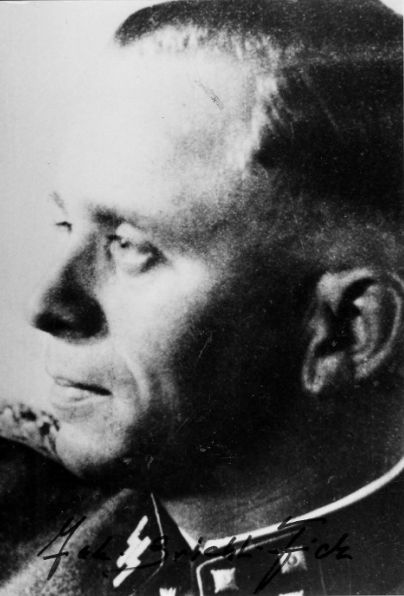Fick, Jacob (Waffen SS)
- Date of birth:
- January 17th, 1912 (Ulm/Danube, Germany)
- Date of death:
- April 22nd, 2004 (Goslar/Lower-Saxony, Germany)
- Service number:
- SS-Nr.: 3.247 // NSDAP-Nr.: 153.672
- Nationality:
- German (1933-1945, Third Reich)
Biography
Promotions:
25.03.1934: SS-Untersturmführer
20.04.1935: SS-Obersturmführer
09.11.1938: SS-Hauptsturmführer
21.04.1942: SS-Sturmbannführer - RDA 01.04.1942
30.01.1944: SS-Obersturmbannführer
30.03.1945: SS-Standartenführer
Career:
00.00.1928: Kdr, Hitlerjugend,Ulm
00.00.1934: entered the SS-VT
05.01.1939: SS-Hstuf, Schwere-Granate-Werfer Lehrgang, Infanterie-Schule Döberitz
10.06.1939-03.03.1941: SS-Hstuf, Chef, 2. Batterie, SS-Flak-Abteilung 2, SS-Division 'Reich' - campaign in Poland and in the West
03.03.1941-15.09.1941: SS-Hstuf, Taktiklehrer, 7. Kriegs-Junker-Lehrgang, SS-Junkerschule Braunschweig
15.09.1941: Chef des Ausbildungsstabes, SS-Freiwilligen-Legion "Norwegen"
01.05.1942-00.10.1942: SS-Stubaf, I. Bataillon, SS-Schnelle-Schützen-Regiment "Langemarck", SS-Reich Division (mot.)
00.10.1942-27.04.1943: SS-Stubaf, Kdr, SS-Kradschützen Abteilung 2, SS-Schützen-Regiment "Langemark", SS-Reich-Division (mot.)
27.04.1943-05.08.1943: SS-Stubaf, Kdr, SS-Aufklärungs-Abteilung 2, 2. SS-Panzer-Division 'Das Reich'
22.11.1943-15.09.1944: SS-Stubaf, Kdr, SS-Panzergrenadier-Regiment 37, 17. SS-Panzergrenadier-Division "Götz von Berlichingen"
00.11.1944-15.12.1944: SS-Ostubaf, Kdr, SS-Panzergrenadier-Regiment 38, 17. SS-Panzergrenadier-Division "Götz von Berlichingen"
24.03.1945-26.03.1945: SS-Staf, Kdr, 17. SS-Panzergrenadier-Division "Götz von Berlichingen"
20.04.1945: SS-Staf, Kdr, SS-Panzergrenadier-Regiment 38, 17. SS-Panzergrenadier-Division "Götz von Berlichingen"
00.00.1950: changed his name to Jacob Briehl Fick
Do you have more information about this person? Inform us!
- Period:
- Second World War (1939-1945)
- Rank:
- SS-Hauptsturmführer (Captain)
- Unit:
- Kdr, SS-Flugabwehr-Maschinegewehr Sturmbann, SS-VT
- Awarded on:
- October 7th, 1939
- Period:
- Second World War (1939-1945)
- Rank:
- SS-Hauptsturmführer (Captain)
- Unit:
- Kdr, SS-Flak-Bataillon, SS-VT Division
- Awarded on:
- July 20th, 1940
- Period:
- Second World War (1939-1945)
- Period:
- Second World War (1939-1945)
- Period:
- Second World War (1939-1945)
- Awarded on:
- 1942
- Period:
- Second World War (1939-1945)
- Rank:
- SS-Sturmbannführer (Major)
- Unit:
- Kommandeur, I. Bataillon, SS-Kradschützen-Regiment "Langemarck", SS-Panzer-Grenadier-Division "Das Reich", Waffen-SS
- Awarded on:
- April 23rd, 1943
“On the 03.03.1943 the SS-Kradschützen-Btl. 2 had the mission of rolling up the Berestowaja ravine (east of Paraskoweja) in a northeasterly direction as far as the woods west of Ochotschaje. The aim was to clear this area of the enemy and link up with the hard-pressed Aufklärungs-Abteilung of the SS-Pz.Gren.Div. ‘Adolf Hitler’. On the night of the 02./03.03.1943 the Bataillon was being used to cover the left flank of the SS-Pz.Gren.Div. ‘Adolf Hitler’ from Losowaja, and thus had to march via Perstowaja during the morning hours to complete its mission. Due to the engineer work being done on the destroyed bridge over the Berestowaja, over the course of the night large elements of the Division had accumulated on the southern bank and stood in several columns on the elevated road along the eastern edge of Losowaja.
The commander of the SS-Kradsch.Btl. 2, SS-Sturmbannführer Fick, had driven to just before the bridge in order to reconnoitre the road conditions, and was expecting his Bataillon (which had itself moved out by the time he started his own recon). Suddenly battle noise was heard in the south. From the high ground about 2 km west of Losowaja, the commander observed thick masses of infantry advancing towards Losowaja and the Berestowaja. He immediately perceived the unfolding dangerous situation for the densely packed elements of the Division, which included vehicle assemblages.
Thus he decided to deploy all idle units for defense and assemble his own Bataillon for a counterattack. He immediately sent all available infantry to occupy the commanding heights just to the south of the Berestowaja bridge. He allowed the not-yet engaged Flak guns and Pak to fight the enemy infantry (which had already penetrated into the first houses on the western edge of Losowaja) from open firing positions. He went back to his own Bataillon, undeterred by the enemy fire, and sent it in to counterattack the already wavering enemy. The counterattack crashed against the enemy who had already been demoralized by the unexpected defensive fire by all weapons, eliminated those hostile elements that had already entered Losowaja and threw the remainder into a disordered rout. The enemy suffered heavy losses in men and materiel in the process.
Over the course of this failed breakthrough attempt, launched in at least regimental strength, the enemy lost the following:
13 guns (12.2 cm)
4 guns (7.62 cm)
1 anti-tank gun (3.5 cm)
1 mortar (17 cm)
1 anti-tank rifle
28 trucks
30 sleds
120 horses
A large number of small-arms and artillery ammunition
200 prisoners
Approx. 650 dead.
Through his swift and ruthless initiative, as well as the coordinated employment of all forces, SS-Sturmbannführer Fick completely wiped out the impending danger of a penetration into the flank of the SS-Pz.Gren.Div. ‘Adolf Hitler’ in just 30 minutes. This had been achieved with the loss of just one man from the friendly forces engaged in this battle.
Through his personal intervention in the foremost line he prevented any setbacks to friendly forces as a result of the sudden flank threat.
This attack, conducted on SS-Sturmbannführer Fick’s own initiative, also created the preconditions for the thrust against Ochotschaje and the relief of the hard-fought Aufklärungs-Abteilung of the SS-Pz.Gren.Div. ‘Adolf Hitler’.”
Sources
- Photo 1: Willi Schumacher Collection
- - FELLGIEBEL, W.P., Elite of theThird Reich, Helion & Company Limited, Solihull, 2003.
- MOONEY, PETER, Waffen-SS Knights and their Battles, Schiffer Publishing, Ltd, 2010.
- SCHNEIDER, J.W., Their Honor Was Loyalty!, Bender (R.James) Publishing, 1993.
- Ehrenliste RK.
- Microfilm Publication A3343. US National Archives.









